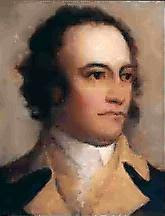 Actual Flag of the Iroquois National Confederacy
Actual Flag of the Iroquois National Confederacy
General John Sullivan.
Independence National Historic Park collection, Philadephia, PA.
License of Imagen is in Public Domain
Account of the 1779 Tragedy of Cherry Valley and Wyoming
Account of the 1779 Tragedy of Cherry Valley and Wyoming
Joe Tyler Headley was born in Delaware County, New York, precisely in Walton. He was born in the same day in which he would die, that is, 84 years later, on December 30, 1897. He was pious Presbyterian clergyman father and scholar, who served as Secretary of the State of New York, and became the associate editor for the newspaper “Tribune” in 1846. More importantly, he was a historian. He has written copiously about historical events with a very suggestive voice that invites his readers to reflect upon the reasons behind those events that he describes for them very well .
In addition, Headley is one of the first authors that have written a book about the Adirondacks and the importance of its environment for healing. Undoubtedly, the place located upstate New York, is one of the most beautiful places in the world; notwithstanding, it is his historical accounts that has attracted me to read Headley and to unearth him from the obscurity in which he has been unjustly placed over all these years. Perhaps, there are interests or fears behind for hiding the methodical and thoughtful research of this prolific writer, who furthermore was a man of unquestionable faith.
Therefore, I have extracted from his book, “Washington and his Generals”, the account of the 1779 massacre of the Cherry Valley and Wyoming in New York State. There were very well organized and civilized communities, and this account is about only two of the 40 villages that were completely converted into ashes.
Incidentally, it was George Washington who ordered General John Sullivan and his troops to “secure” the frontier against the Iroquois, as a preemption tactic, in case they would have become a threat as being influenced by the English to attack them, the then recently newly formed Americans. The official history tell many "stories" about the facts and the position of those original Americans nations, for once, one thing seems to be sure, these people were one of the first democracies in America and for such reasons, it has been recorded that they voted about this revolucianary war of independence. At least one of the six nations of Iroquois, also called as the “People of the Longhouse”, or of the “People of Peace and Power”, did vote for remaining neutral about the war between the loyalists, the British and the colonies.
Anyway, here is the account from the vantage point of a trained professional writer, politician and historian, who by the way was not an “Indian” but only a man of true faith:
Here it is Headley's account:
Here it is Headley's account:
The first of May 1779, the troops under General John Sullivan commenced their march but did not arrive at Wyoming until the middle of June…
The village 1aid immediately set on fire, and the rich fields of corn were cut down and trodden underfoot. On the first of September, the army, left the river, and struck across the wilderness…
Once or twice the Indians threatened to make a stand for their homes, but soon fled in despair and the army had its own way. The capital of the Senecas a town consisting of sixty houses, surrounded by beautiful cornfields and orchards, was burned to the ground and the harvest destroyed.
…The fourth day it reached a beautiful region, then, almost wholly unknown to the white man... As the weary columns slowly emerged from the dark forest and filed into this open space… they seemed suddenly to be transported into an Eden.
The tall ripe grass bent before the wind—cornfield on cornfield as far as eye could reach waved in the sun—orchards that had been growing for generations, were weighted down under a profusion of fruit—cattle grazed on the banks of a river, and all was luxuriance and beauty…. All about were scattered a hundred and twenty-eight houses—not miserable huts huddled together, but large airy buildings, situated in the most pleasant spots, surrounded by fruit trees, and exhibiting a civilization on the part of the Indians never before witnessed.
Soon after sunrise immense columns of smoke began to rise the length and breadth of the valley, and in a short time the whole settlement was wrapped in flame, from limit to limit; and before night those one hundred and twenty-eight houses were a heap of ashes. The grain had been gathered into them, and thus both were destroyed together. The orchards were cut down, the cornfields uprooted and the cattle butchered and left to rot on the plain. A scene of desolation took the place of the scene of beauty, and the army camped that night in a desert.
The next day, having accomplished the object of their mission, Sullivan commenced a homeward march…. The thanks of Congress was presented to Sullivan and his army for the manner in which they had fulfilled their arduous task.
Bibliography
Headley, J. T. (1854). Washington and His Generals (Vol. I). New York, NY: C. Scribener.



No comments:
Post a Comment